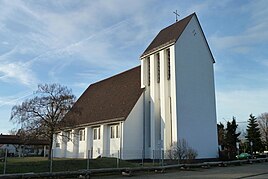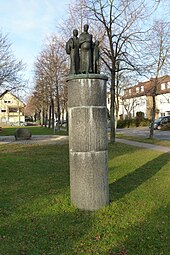Sankt Stephans settlement
|
Sankt Stephans settlement
City of Griesheim
Coordinates: 49 ° 51 ′ 18 ″ N , 8 ° 34 ′ 53 ″ E
|
|
|---|---|
| Height : | 97 m above sea level NN |
| Area : | 47.3 ha |
| Incorporation : | January 1, 1977 |
| Postal code : | 64347 |
| Area code : | 06155 |
|
Catholic Church of St. Stephen (1953)
|
|
The Sankt Stephans-Siedlung is a settlement in Griesheim in the southern Hessian district of Darmstadt-Dieburg .
Geographical location
Like Griesheim, Sankt Stephan is located in the relatively flat, sandy plain of the Hessian Ried . The elongated Sankt Stephans settlement borders on the southeast of the Griesheim core city, wedged between it and the August Euler airfield . It is divided into corridors 115, 116 and 117 of the Griesheim district and covers a total area of 47.30 hectares. This area is almost completely built-up and merges seamlessly with the development of the core city. The settlement essentially comprises the following streets around St.-Stephans-Platz: in the west Draustraße to Maria-Theresia-Straße, in the center Donaustraße, Murstraße and Theißstraße, in the northeast Nehringstraße, Lilienthalstraße, Zeppelinstraße and Parsevalstraße.
history
The area in which the settlement was to emerge from 1948 onwards was separated from the Griesheim district in 1938 with the Griesheim military training area and was incorporated into the city of Darmstadt. With the active support of Darmstadt's Lord Mayor Ludwig Metzger , a settlement for displaced Hungarian-German families was created here after the Second World War on the outermost edge of Darmstadt's urban area in the vicinity of the military airfield . The area is characterized by glacial drift sands, suffers from drought and wind erosion and is agriculturally unproductive. In addition, the military past of the area and the still existing military restricted zones made the emergence of the new community difficult. The first wave of settlers who settled on Donaustraße was followed by a second wave in 1949/1950 made up of relatives of these settlers who were previously scattered all over Germany. At that time, between fourteen and twenty people were registered with the police in every six-room settlement. The construction of the settlement was carried out with a lot of family work .
According to the plans of the planners, St. Stephen's should receive the floor plan of an east-facing Christ body in the final construction, with the village green around Draustraße forming the body and the church on St.-Stephans-Platz the head. At right angles to this, two streets were to extend from there like outspread arms, the Donaustraße to the north and another to the south, which, however, could not be realized due to the continued military use of the site.
The settlers initially cultivated two hectares each, later three hectares of land. With pig fattening, potatoes, corn and vineyards created a first meager livelihood as self-sufficiency. The settlers popularized the use of paprika in the region. Many later switched to growing asparagus . In the course of time, the development of the settlement plots was considerably densified. New building areas were also opened up beyond the original settlement area.
As part of the regional reform in Hesse , on January 1, 1977, the residential area of the settlement with around 2000 inhabitants was subdivided from the city of Darmstadt to Griesheim, with which it had long since grown together. The cultivated fields in the south remained in the Darmstadt district.
Culture
The St. Stephans also got together for social and cultural tasks. They created a reference and sales cooperative (1948), the volunteer fire brigade (1949), the parish youth (1949), a choir (1951) - now a church choir -, a folk dance group (1952), a sports club (1953), a local group of German Red Cross (1956) and a Carneval Association (1960).
The city of Griesheim provided for the construction of a town house in 1981/82 and in 1988/89 for the redesign of St.-Stephans-Platz as a green and play area with a memorial for the eviction . The establishment of a parish center brought a further improvement in the living conditions in this district.
Individual evidence
- ↑ Law on the reorganization of the districts of Darmstadt and Dieburg and the city of Darmstadt (GVBl. II No. 330–334) of July 26, 1974 . In: The Hessian Minister of the Interior (ed.): Law and Ordinance Gazette for the State of Hesse . 1974 No. 22 , p. 318 ff ., § 3 ( online at the information system of the Hessian state parliament [PDF; 1.5 MB ]).
- ↑ Abridged from the text by Karl Knapp "Griesheim - From the Stone Age Settlement to the Living City"
Web links
- Saint Stephen. In: Internet presence of the city of Griesheim.
- Sankt Stephans-Siedlung, Darmstadt-Dieburg district. Historical local dictionary for Hessen. In: Landesgeschichtliches Informationssystem Hessen (LAGIS).


